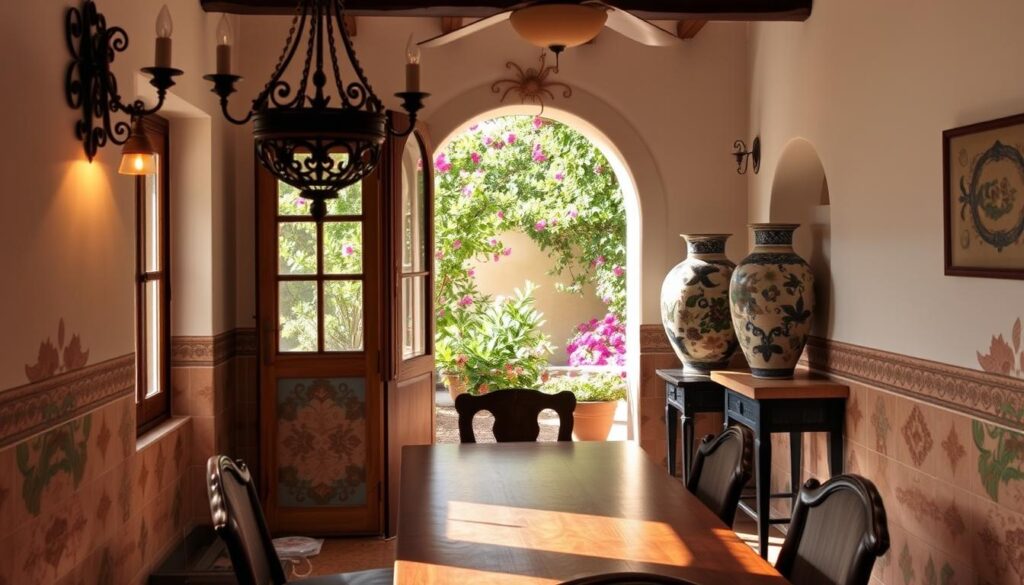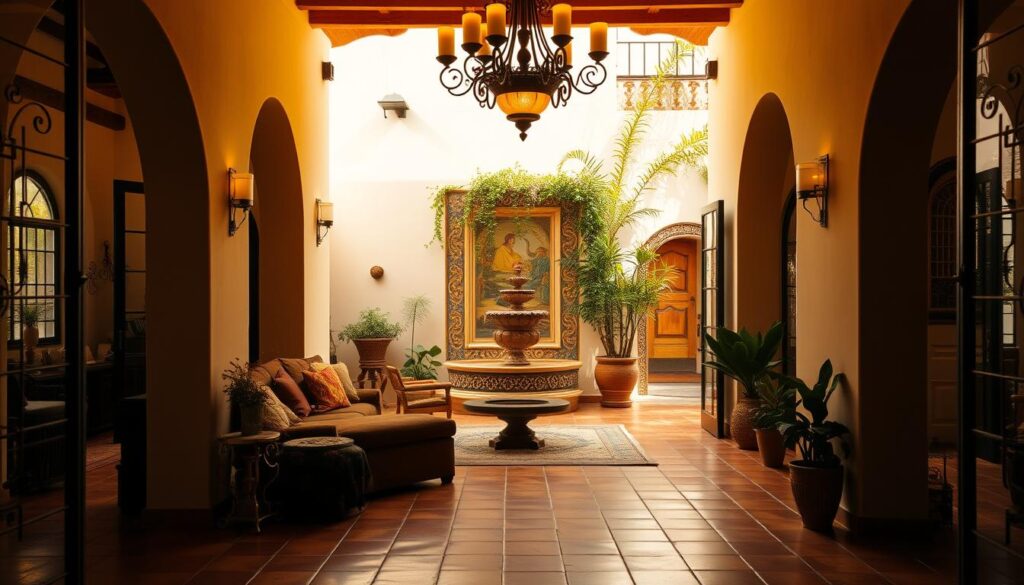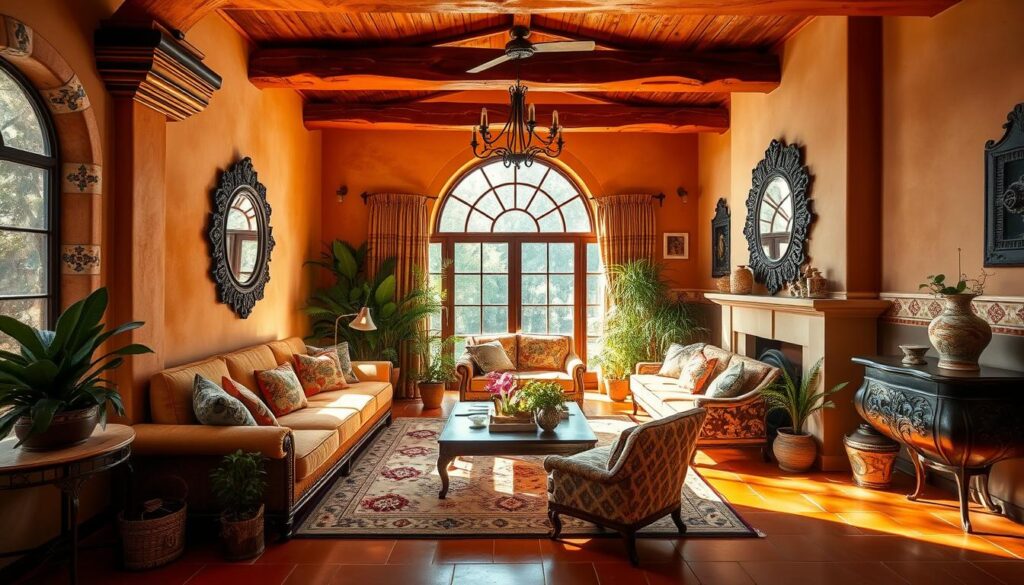Did you know Spanish-style homes are very popular in the U.S.? They are known for their bright colors, detailed patterns, and fancy touches. This makes them feel warm and welcoming.
Spanish interior design celebrates a rich cultural heritage. It combines warmth, elegance, and rustic charm. We can help you bring this unique style into your home. You can use elements that show off the beauty of modern Spanish homes.
Key Takeaways
- Understand the historical influences behind Spanish interior design
- Learn the key characteristics of this unique style
- Discover practical tips on how to incorporate Spanish interior design into your space
- Explore the use of vibrant colors and intricate patterns
- Create a cozy and inviting atmosphere with ornate details
Understanding Spanish Home Interior Design
To truly appreciate Spanish home interior design, one must understand its deep-rooted history and cultural significance. It’s not just about looks; it’s about making a space warm and inviting. This reflects the country’s rich heritage.
Spanish interior design has been shaped by various cultures, including the Moors and the Mediterranean influence. This mix is seen in the architectural elements and decorative features of Spanish homes.
The Historical Influence on Design
The historical influence on Spanish interior design is deep. The Moors introduced intricate tile work, arches, and domes. These have become key parts of Spanish architecture. The Mediterranean influence added warm, earthy tones and a focus on outdoor living.
Key Historical Elements:
- Intricate tile work
- Arches and domes
- Warm, earthy tones
- Outdoor living spaces
Key Characteristics of Spanish Style
Spanish style is known for rich textiles, earthy colors, and decorative tile work. These elements create a warm, inviting atmosphere that is quintessentially Spanish.
| Characteristic | Description |
|---|---|
| Rich Textiles | Use of luxurious fabrics such as velvet and silk |
| Earthy Color Palettes | Warm tones such as terracotta, sienna, and golden brown |
| Decorative Tile Work | Intricate, hand-painted tiles often featuring geometric patterns |
By understanding these key characteristics, we can appreciate the beauty and elegance of Spanish design. Whether you prefer traditional Spanish decor or modern Spanish interior design, these elements can make your space unique and inviting.
Elements of Spanish Design
Spanish interior design has several key elements that make a space unique and welcoming. The rustic Spanish interiors style focuses on warmth and elegance. It uses a variety of design components to achieve this.
Rich Textiles and Fabrics
Spanish design is known for its rich textiles and fabrics. Velvet, linen, and patterned fabrics add depth and warmth. They make a room cozy and inviting.
Velvet drapes add luxury, while linen brings freshness and simplicity. Mixing these fabrics creates the layered, textured look of Mediterranean home interior design.
Earthy Color Palettes
The color palette in Spanish design reflects the Spanish landscape. Shades of terracotta, sienna, and golden brown are common. They create a warm, welcoming space.
To bring this into your home, use terracotta walls, sienna woodwork, and golden brown accents. This palette captures the warmth and hospitality of Spanish culture.
Decorative Tile Work
Decorative tile work is a key feature of Spanish design. It features intricate patterns and vibrant colors. Tiles adorn walls, floors, and ceilings, adding traditional Spanish craftsmanship.
Decorative tiles offer endless creativity and personalization. From geometric to floral patterns, the choices are vast. This element is essential for a visually appealing, authentic Spanish interior.
Furniture Choices for Spanish Interiors
Choosing the right furniture is key to a warm Spanish-style home. Spanish design mixes tradition with elegance. This makes picking furniture a big part of the design.
Rustic and Handcrafted Selection
Rustic and handcrafted furniture is a hallmark of Spanish design. Distressed or intricately carved pieces add authenticity and warmth. They make your home feel special.
A handcrafted wooden console or a distressed leather armchair can highlight your living room. These pieces remind you of a Spanish villa. Solid woods like oak and pine are popular for their beauty and durability.
Use of Wood and Metal Accents
Spanish interiors also feature metal accents, like wrought iron, for elegance. Wrought iron adds luxury with candle holders and door hardware. It brings a touch of class to your space.
Wood and metal together create a beautiful contrast in Spanish design. For example, a wooden table with wrought iron chairs or a metal chandelier over a wooden console is stunning. It shows off the best of both materials.
| Material | Characteristics | Examples |
|---|---|---|
| Wood | Rustic, distressed, handcrafted | Wooden console tables, carved wooden doors |
| Metal | Elegant, sophisticated, wrought iron | Wrought iron candle holders, metal chandeliers |
Choosing furniture that combines these elements creates a welcoming Spanish-style home. Whether it’s a cozy apartment or a large villa, the right furniture makes it beautiful and timeless.
Lighting in Spanish Home Design
Spanish home design focuses a lot on lighting. It aims to make spaces feel open and sophisticated. The right lighting can change a room’s feel, adding warmth and elegance.
Natural Light and Open Spaces
Spanish homes love natural light and open areas. Big windows, often with detailed woodwork or iron, let in lots of sunlight. This makes rooms bright and airy.
Using sheer curtains or blinds helps bring in more natural light. It also connects the inside with the outside, a key part of modern Spanish interior design.
Traditional Fixtures and Chandeliers
Traditional lighting is also key in Spanish homes. Chandeliers, sconces, and pendant lights are often fancy and detailed. They add elegance and sophistication.
“Lighting is not just about illumination; it’s about creating an atmosphere. In Spanish homes, it’s used to evoke a sense of warmth and hospitality.”
Choose lighting that fits the room’s size and feel. A big chandelier looks great in a large dining room. Smaller sconces can warm up a cozy reading area.
| Lighting Type | Description | Best Use |
|---|---|---|
| Chandeliers | Ornate, grand fixtures | Dining rooms, entryways |
| Sconces | Wall-mounted, often intricately designed | Living rooms, hallways |
| Pendant Lights | Single fixtures, often used in series | Kitchens, dining areas |
By mixing natural light with traditional fixtures, you can make your Spanish-style home warm and inviting. It captures the heart of Spanish home interior design.
Incorporating Spanish Architecture
Adding Spanish architecture to your home can make it look better. It mixes indoor and outdoor areas well. This style uses arches, courtyards, and focuses on living outside.
Arched Doorways and Windows
Arched doorways and windows are key in Spanish architecture. They bring elegance and connect indoor and outdoor spaces. Arches can be used in many ways, like framing windows and doors or as passageways.
Outdoor Living Spaces
Outdoor living is a big part of Spanish architecture. You’ll find courtyards, patios, and terraces. These spots are great for relaxing, having fun, or just enjoying the fresh air.
| Feature | Description | Benefits |
|---|---|---|
| Arched Doorways | Adds elegance and sophistication | Creates a sense of continuity between indoors and outdoors |
| Courtyards | Provides a tranquil oasis | Perfect for relaxation and entertainment |
| Terraces | Expands living space outdoors | Offers panoramic views and fresh air |
By adding these features, your home can look and feel Spanish-inspired. We can mix old Spanish architecture with today’s comforts and needs.
The Role of Art in Spanish Design
Spanish design is known for its rich artistic heritage. This is seen in homes that showcase this style. Art deeply influences Spanish interiors, adding beauty to every corner.
Hand-painted ceramics and pottery are key in Spanish design. These items are not just useful but also add charm to any room. From vases to plates, they bring Spanish craftsmanship into your home.
Hand-painted Ceramics and Pottery
Hand-painted ceramics in Spain have a long history. Each region has its own style and techniques. These ceramics add color and personality to kitchens and dining areas.

Emphasizing Local Artists
Spanish design also values local artists. Using their work adds authenticity and cultural depth to homes. This supports Spanish artistry and helps keep traditional crafts alive.
Local artists bring their unique perspectives and skills. Their work includes paintings, sculptures, and textiles. This offers many choices for those wanting to add Spanish art to their homes.
Wall Murals and Tapestries
Wall murals and tapestries are also important in Spanish design. They can change a room, adding drama and interest. Often, they show scenes from Spanish history or nature.
By using these artistic elements, homes become beautiful and deeply rooted in Spanish culture. Whether through ceramics, local art, or wall murals, Spanish design enriches homes with art and character.
Landscaping for Spanish-Inspired Homes
A mediterranean home interior looks great with landscaping that shows off the region’s beauty. We aim to make the outdoor areas of a Spanish-inspired home blend smoothly with the inside.
Spanish-style homes are known for their courtyards and patios. These spots are filled with decorative tile, fountains, and greenery. They offer a calm place for relaxation.
Courtyards and Patios
Courtyards and patios are the heart of Spanish outdoor living. We make them cozy and welcoming. They often have comfy seating, outdoor kitchens, and fire pits.
We add natural materials like stone and wood to these areas. This gives them warmth and character. Water features and plants also help create a peaceful vibe.
Drought-Resistant Plants
In the Mediterranean climate, drought-resistant plants are key. Succulents, olive trees, and lavender are favorites. They’re tough and add beauty and scent to the space.
We choose plants native to the Mediterranean. They thrive in the local climate. This means less watering and care for the plants.
With these elements, we craft an inviting outdoor space. It matches the elegance of a Spanish-inspired home, showing off Spanish villa decorating’s charm.
Tips for Achieving a Spanish Aesthetic
Creating a Spanish-inspired home is about mixing old and new. It’s also about adding personal touches that show your heritage. As we dive into Spanish home interior design, we’ll see how to mix traditional and modern styles.
Combining Old and New Elements
Traditional Spanish decor often mixes antique pieces with modern furniture. This mix makes your home welcoming and unique. For example, a vintage armchair paired with a modern sofa can make your living room special.

When mixing old and new, think about the style of your antique items. Then, choose modern pieces that match their look. This way, your home will have a unified style that shows your taste.
Personal Touches and Family Heritage
Adding personal touches, like family heirlooms and cultural items, brings history and heritage to your home. “Home is where the heart is,” and personal elements make it truly yours. Display vintage family photos, antique furniture, or traditional Spanish pottery to add warmth and personality.
“The home should be the stage for family life, a place where memories are made and traditions are kept.”
By adding these personal touches, your home will reflect your style and tell your family’s story.
Budgeting for Spanish Interior Design
Creating a Spanish-style home doesn’t have to be expensive. With smart planning, you can get a real Spanish look without spending a lot. The trick is to find affordable materials that still capture the essence of Spanish design.
For a rustic Spanish interior, focus on adding warmth and character. Use reclaimed wood, vintage items, and local materials to do this.
Cost-Effective Solutions
Repurposing materials is a great way to save money. For example, old wooden doors can become unique headboards or coffee tables. This adds a contemporary Spanish design touch to your home.
- Look for second-hand or vintage items to decorate with.
- Paint old furniture to give it a new look instead of buying new.
- Choose local materials to cut down on shipping costs.
Here’s a table showing how repurposing can save money on a typical Spanish-style renovation:
| Material | New Cost | Repurposed Cost |
|---|---|---|
| Wooden Beams | $500 | $200 |
| Decorative Tiles | $300 | $150 |
| Wrought Iron Fixtures | $800 | $400 |
Sourcing Authentic Materials
Getting the right materials is key for an authentic Spanish look. This includes Spanish tiles, handmade ceramics, and traditional textiles. These items might seem pricey, but they add lasting beauty and value to your home.
To find these materials, visit local markets or Spanish import stores. Online stores that specialize in Spanish decor are also good resources.
By watching your budget and being smart about where you find materials, you can create a stunning Spanish-style home. It will showcase the beauty and warmth of Spanish culture.
Bringing the Vision Together
As we wrap up our exploration of Spanish interior design, it’s time to put it all together. We can make a warm and welcoming space that shows off Spanish culture’s beauty and elegance. This is done by using the ideas we’ve talked about.
Creating a Unified Space
To get a cohesive look, we must mix rich textiles, earthy colors, and decorative tile work. These elements combined create a space that feels spanish style home decor and classy.
Adding Final Touches
Decorative accessories and textiles add the final touches, bringing personality and flair to our home. By adding modern Spanish interior design, we make a space that’s unique and inviting. It shows off our personal style.


